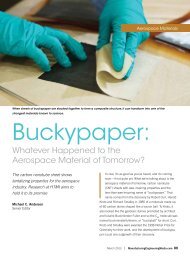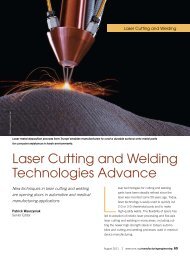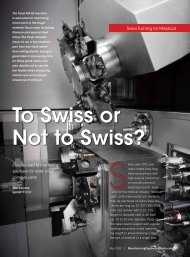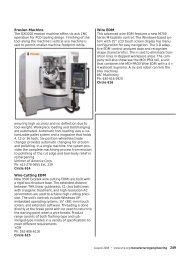Click here for PDF - Society of Manufacturing Engineers
Click here for PDF - Society of Manufacturing Engineers
Click here for PDF - Society of Manufacturing Engineers
You also want an ePaper? Increase the reach of your titles
YUMPU automatically turns print PDFs into web optimized ePapers that Google loves.
Materials<br />
component marketplace,<br />
expects growth in the medical<br />
industry, which currently<br />
accounts <strong>for</strong> 40% <strong>of</strong> its<br />
manufacturing.<br />
MacNeal’s entire career<br />
has been in FDA-regulated<br />
industries; she kindly walked<br />
ME Media through a virtual<br />
bazaar <strong>of</strong> medical materials<br />
Tracy MacNeal, chief strategy and discussed their strengths<br />
<strong>of</strong>ficer at ATW Companies. and challenges.<br />
Implants: Biocompatibility and Wear Issues<br />
Implants, orthopedic and otherwise, are all FDA Class<br />
Two and Class Three devices, with stringent requirements,<br />
the <strong>for</strong>emost <strong>of</strong> which is biocompatibility, MacNeal said. “Of<br />
the materials that are favored from a biocompatibility standpoint<br />
in metals, titanium would be the number one choice <strong>for</strong><br />
implants—it’s basically inert in the body. T<strong>here</strong> are also some<br />
alloys <strong>of</strong> stainless steel—people talk about ‘surgical stainless<br />
steel’ and those two would be the two big ones.”<br />
But as manufacturers in other industries know, titanium<br />
has its challenges: “Titanium is difficult to work with<br />
because it does catch fire. When you’re machining it, you<br />
really have to control your feeds and speeds. Its ratio <strong>of</strong><br />
hardness to brittleness is not great, and it doesn’t have<br />
good wear properties—it abrades. In an articulating joint<br />
like a knee or hip, you can’t have metal-on-metal t<strong>here</strong>, it’s<br />
much too s<strong>of</strong>t.”<br />
Cobalt chrome, another popular medical metal, has been<br />
used as a wear surface in orthopedic implants, but, as has<br />
been widely reported, it’s under fire right now: “People who<br />
have cobalt chrome metal-on-metal interfaces in their orthopedic<br />
joints get wear debris resulting in much higher than average<br />
levels <strong>of</strong> chromium ions in their body,” MacNeal noted.<br />
78 <strong>Manufacturing</strong>EngineeringMedia.com | May 2013

















